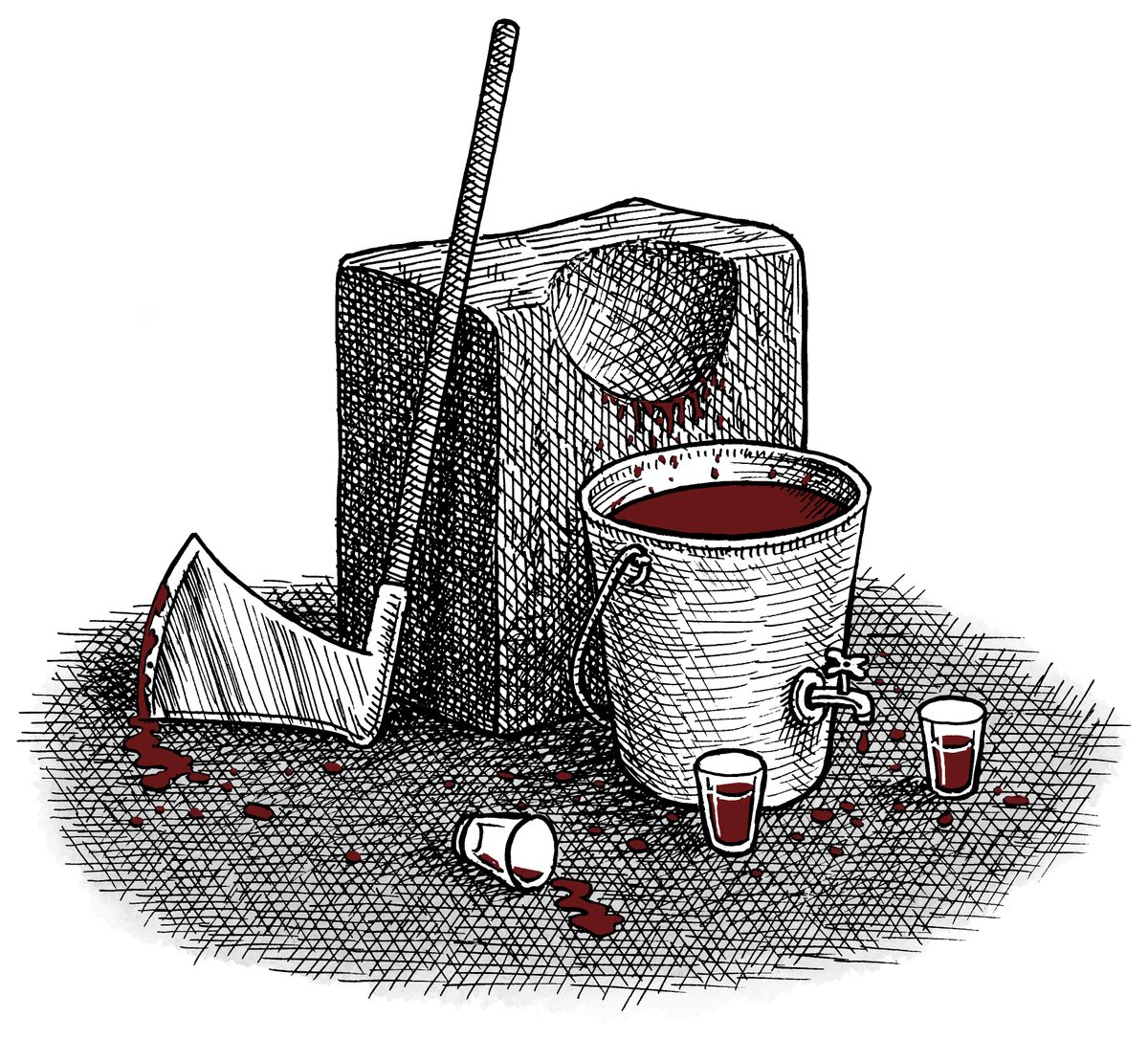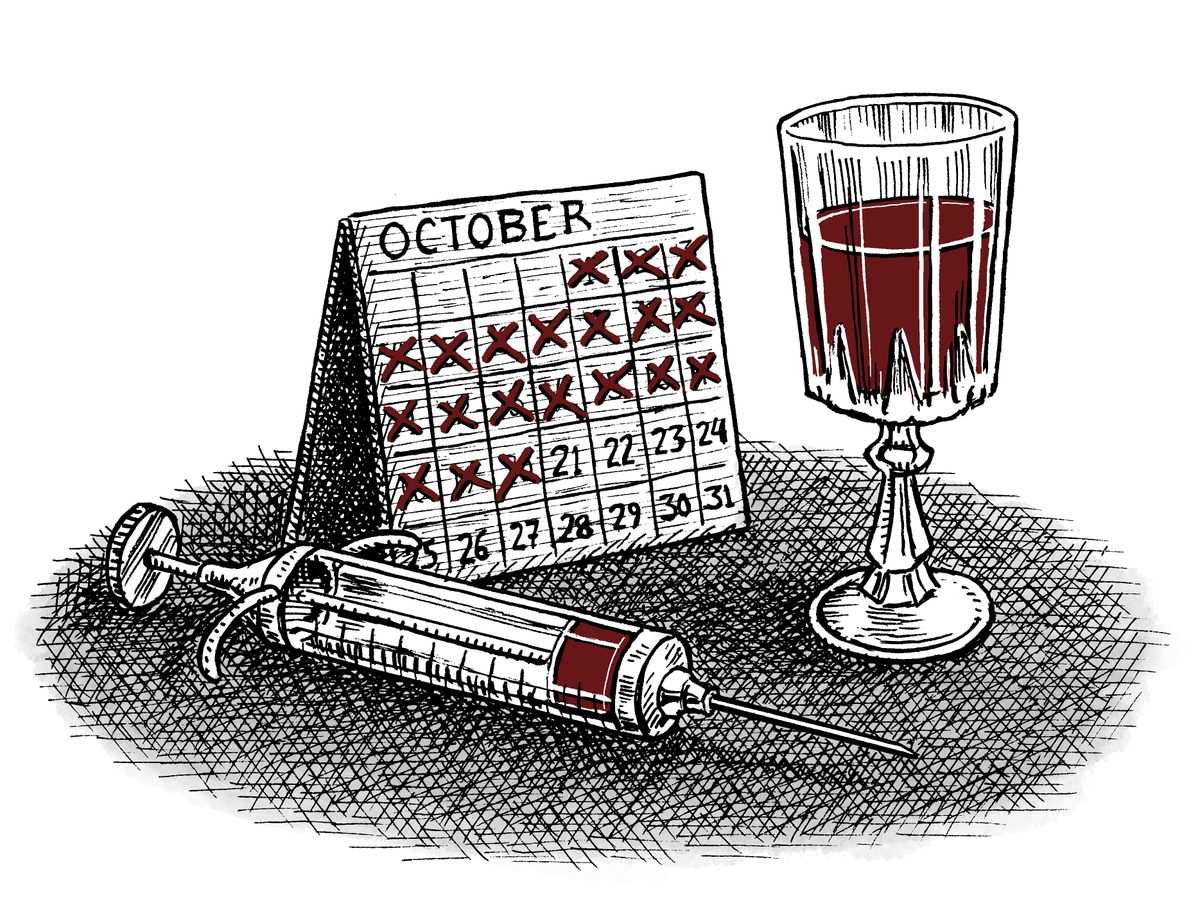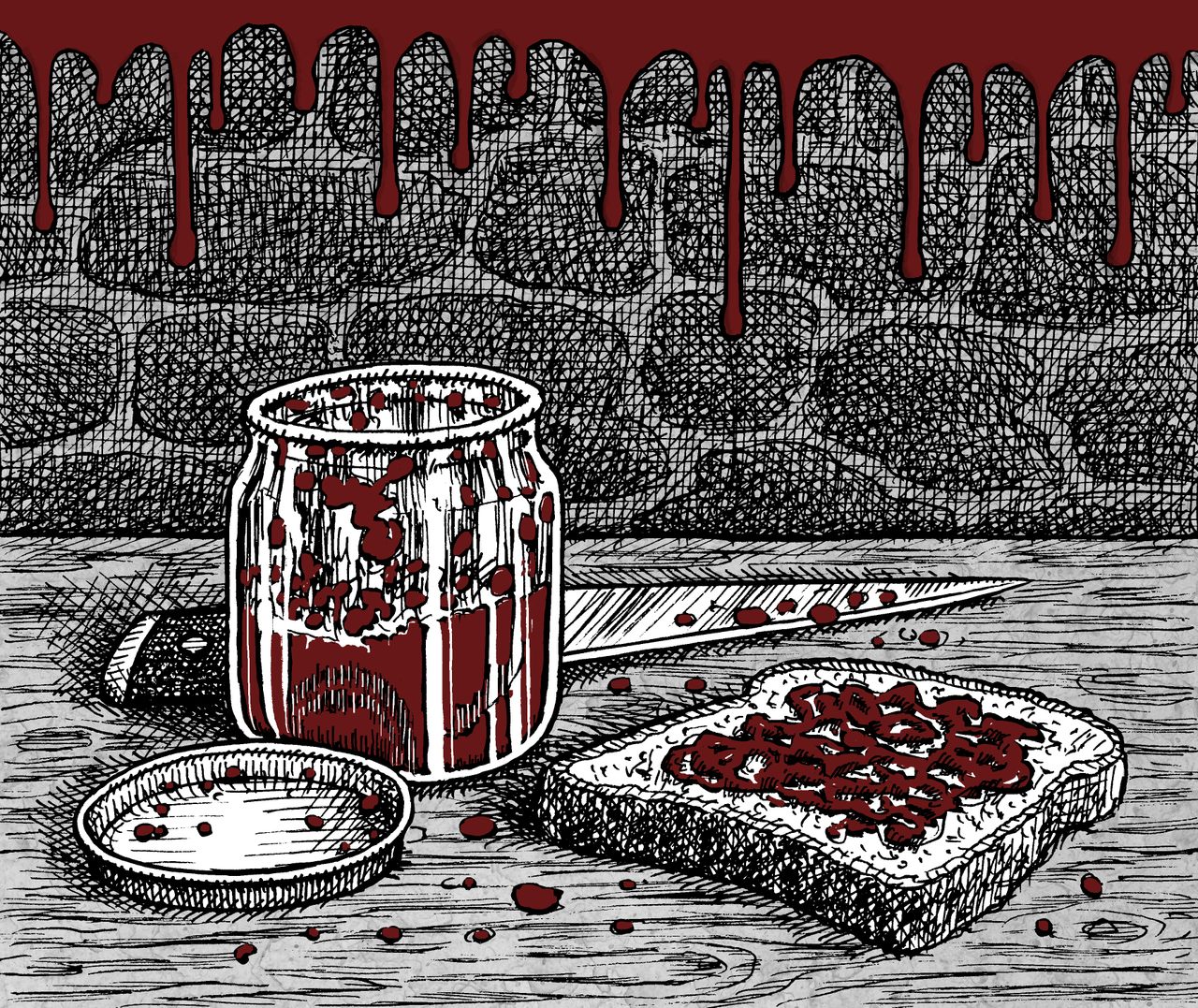The Strange Endurance of Consuming Human Blood for Our Health
From draining slain gladiators to modern-day “sangs,” people have long looked to blood as a panacea.
In 1679, a Franciscan apothecary recorded the recipe for a supposedly medicinal jam made not of fruit, sugar, and spice, but solely of human blood.
The brother’s notes don’t say how much blood each batch of this macabre jam requires, or how to collect it. However, they are eerily specific about whom one ought to drain: “Persons of warm, moist temperament, such as those of a blotchy, red complexion and rather plump of build.”
Fresh blood should be left out until it congeals into “a sticky mass,” the recipe explains, then spread out onto a softwood table and “cut into thin slices, allowing the watery part to drip away.” Once dried out, the slices should be placed on a stove and stirred with a knife until they’ve turned into a batter, then transferred into a warm bronze mortar and pounded through a sieve “of finest silk” into a glass jar. It can then be sealed and stored away for future use—but the notes specify that anyone using the jam ought to top up their stores with freshly-processed blood every spring.
This recipe wasn’t a late-Renaissance attempt at black humor, or a telltale sign of some forgotten friar serial killer. It was just one of many techniques people developed, across the globe and over the centuries, for the preparation and consumption of human blood—not to survive desperately lean times but to harness the vital medicinal power they believed it carried. In fact, compared to some approaches people have taken to ingesting each other’s blood, this jam actually is pretty mild stuff.
As with most ancient practices, no one’s sure when, where, or why people started using human blood as a medicinal ingredient. Richard Sugg, the historian who wrote the book about these sorts of practices (Mummies, Cannibals and Vampires: The History of Corpse Medicine from the Middle Ages to the Falun Gong), says the earliest documented cases of consuming human blood come from ancient Rome. Notably, Pliny the Elder, the 1st century CE naturalist, describes spectators descending on wounded or slain gladiators “to quaff the warm, breathing blood from man himself, and, as they apply their mouth to the wound, to draw forth his very life.”
But modern historians believe the Romans borrowed their blood-drinking practices from even older Etruscan rituals, and many of their ideas about blood’s supposed medicinal and magical values from Greek physician-philosophers. Later records suggest that cultures far outside of the Roman sphere of influence, such as China, almost certainly had their own distinct medicinal human blood consumption traditions, as well. We just don’t have much clear, contemporary evidence on them—only a few cursory mentions of the broad value of the ingredient in medical manuals.
Thomas DeLoughery, an Oregon Health & Science University hematologist, explains that most historical cultures likely deduced a connection between blood and vitality by observing the effects of blood loss. “You get fatigued, pale, and weak—and if you lose too much you die,” he says. “So it may seem logical that ingesting blood would make one stronger.” Through consumption, an individual could directly incorporate another’s seemingly potent life essence into their body.
“Blood is the key to life!” DeLoughery stresses.
Many practices also seemingly drew upon theories of “sympathetic medicine,” which held that the best or only way to cure an affliction was contact with or the consumption of something related to the affliction, or the afflicted part of the body. Although animal parts could work in a pinch, many traditions held that the closer the treatment was to the ailment, the better it would be—which made human blood the superior tonic. Versions of this broad belief system crop up from antiquity to modern day, and all across Eurasia—at least. (Notably, these ideas recur in traditional medicine systems across East Asia.)
The Romans (and many later European cultures) turned to human blood to treat epilepsy, for example, as they believed it was a disease of the soul and thus an infusion of soul-bearing blood from a suitable young, healthy body would assuage it. Granted, Europeans often colored this baseline belief with alchemical-humoral logic, explaining blood’s potency in terms of its elemental properties.
In reality, DeLoughery says, blood “is an electrolyte solution, so it may help if dehydrated.” It also contains a ton of iron, which may help people with anemia—but it was hardly the only historically accessible source of iron. “Most of us can only absorb a limited amount every day,” DeLoughery adds. Beyond this, blood doesn’t have any known potential health benefits. Rather, consuming human blood can be a health hazard, as it’s a route of transmission for many diseases. “In theory, if you drink a lot of blood over time you may also get iron-overloaded,” DeLoughery explains; iron toxicity can cause liver, lung, and nerve damage, and a ton of broad resultant health issues.
But if someone suffering from an illness consumed human blood and then recovered, it was easy to assume the blood was to be credited for their recovery. The periodic nature of epilepsy in particular may have convinced some folks that blood truly did help them—so long as they kept drinking it.

Scattered accounts suggest that the Romans continued quaffing gladiators’ blood right up to the start of the 5th century, when Christian mores finally put the kibosh on these games. But these prohibitions apparently focused on the competitions, not the blood drinking that accompanied them. The late Romans and their descendants reportedly just turned from fallen fighters to folks facing executions as their go-to source of fresh, young blood moving forward.
Most of the records of human hematophagy in Europe especially come not from deep antiquity, but the early modern era, as part of wider accounts of “corpse medicine,” the use of human body parts as sympathetic medicine components. Even figures we now consider the forefathers of modern, empirical science endorsed human blood consumption—such as Robert Boyle, the Irish naturalist and innovative chemist, who was reportedly obsessed with the idea that the essence within blood could act as a borderline panacea.
“Medicinal blood drinking occurred especially in northern Europe,” says Sugg, but there’s also a fair amount of early modern evidence of the practice in parts of southern Europe, in China, and in both European colonial and Indigenous communities in the Americas and Australia at least.
It’s often hard to grasp how widespread human hematophagy was in any specific place or time, or what drinkers or eaters thought about it, given the limitations of historical evidence, Sugg notes. Accounts that describe Louis XI of France and Pope Innocent VIII drinking the blood of young boys for their health in the late 15th century can make it seem like a strange, elite practice. But consistent accounts of people in Germanic and Scandinavian countries flocking to executions en masse in the 17th and 18th centuries in the hopes of catching some spilled blood to consume, often on the spot, suggest in some places it was common.
Granted, while folks across time and space agreed blood was a potentially potent ingredient they were constantly coming up with new ideas about when and how to prep and consume it. Almost everyone from Pliny to Paracelsus, the Renaissance Swiss physician credited with bringing chemistry into the study and practice of medicine, ascribed to the idea that the blood of a young, healthy man was best, as it would contain the most raw vitality. But some considered menstrual blood a potent ingredient in its own right, while others considered it toxic. Throughout the early modern era, “educated chemists or doctors believed blood must be prepared” before consumption, Sugg adds. This logic gave us Franciscan blood jam—as well as recipes for distilled blood liquors and floury blood powders. But “popular belief preferred it hot, and direct from a beheading.”
Although human hematophagy was widely practiced for centuries, it always had critics. Notably, the prominent 16th-century herbalist Leonhart Fuchs denounced all forms of corpse medicine as unconscionable cannibalism. But it only started to lose its hold in Europe in the late 18th century, Sugg explains, as scientists gave in to overwhelming evidence that blood was not the seat of the soul, or a proven panacea. New popular ideas about heredity led to concerns about the possible dangers of consuming the flesh of unknown others—especially condemned criminals.
But these evolving views on blood and human blood consumption took decades to spread, and to penetrate every layer of society, Sugg adds. Notably, the last recorded attempt by a bystander to drink blood from the body of an execution victim comes from a German hanging in 1908.
It’s still common to hear people speak, with great conviction, about the power of “blood ties,” the vigor of “young blood” and the value it can bring to a venture, or core characteristics that flow “in our blood.”
These lingering beliefs about the potency of blood arguably led to the brief proliferation of shady “parabiosis” services in the mid-2010s. Drawing on limited research into how the protein composition of our blood changes as we age, and how reinfusing older people’s blood with proteins more common in younger people could potentially lead to positive health effects, these services offered to transfuse the blood of young, healthy donors into older, wealthy people. Popular misunderstandings about these procedures led to such a surge in digital chatter about the possible health benefits of drinking young people’s blood in 2018 that Snopes felt the need to debunk it.

Old-school ideas about blood are also rife in the world of “sanguinarians,” people who believe they need to consume other people’s blood, often daily or several times a week, for their health.
Although laypeople sometimes refer to them as “real-life vampires,” most “sangs” reject this label because of the stigmas associated with it—and because they simply aren’t predatory, supernatural creatures. Sanguinarians get blood from donors (usually friends, family, or partners) with active consent, using syringes or lancets rather than their teeth, and while observing safety measures to avoid disease transmissions. Often, they drink blood fresh from a vein, but Joseph Laycock, a scholar at Texas State University who’s studied the community, says he’s “aware of self-identified vampires who consume menstrual blood,” too.
It’s hard to say how common sanguinarians are, as taboos about human hematophagy force most to keep a low profile. But recent estimates suggest there are at least 5,000 active sangs in the United States alone. And most who’ve spoken publicly say they didn’t start drinking blood because of some abiding interest in vampire lore, or corpse medicine. Instead, they insist that they were drawn to human blood drinking almost as a compulsion, or matter of instinct, says John Edgar Browning, a professor at the Savannah College of Art and Design who’s also studied sanguinarians. They don’t believe human blood cures mundane illnesses—just that something about them means their well-being depends on blood drinking. Without it, they report feeling depressed, tired, or just generally terrible.
Sanguinarians aren’t the only people who still drink other humans’ blood today. Machine Gun Kelly and Megan Fox’s admission earlier this year about how they’ve drank each other’s blood as part of their relationship put a spotlight on the sexual fetish of blood play. Occasional murder cases involving human blood consumption show that sometimes it can be a facet of wider pathologies or violent behaviors. And a few scattered cases suggest that some folks cook with their own blood, or others’, for the sheer sake of experimentation.
Back in 2011, Jamie Vulva, a woman who runs a plant-based café in Olympia, Washington, chronicled her experiments with using her own menstrual fluid to bake cookies. Vulva says she went down this rabbit hole on a whim. But she decided not to cook with blood again because the cookies didn’t turn out well (too floury), she’s not a fan of the taste of blood overall, and she feels no underlying compulsion to consume blood.
Vulva and other folks who’ve explored eating or drinking blood as a matter of sexual gratification, sinister compulsion, or sheer shiggles in recent history don’t necessarily ascribe to old, poetic notions about blood or vital essences. So they’re almost certainly not connected, directly or indirectly, to ancient, socially-sanctioned human hematophagy practices. But that just means that they stand as proof of the diverse, enduring forces that may pull people toward consuming human blood.
Of the fact that, no matter how divorced we feel from things such as Franciscan blood jam, blood is still such an omnipresent, potent, and fascinating facet of life, some of us will always find an excuse to put it in our mouths.
Gastro Obscura covers the world’s most wondrous food and drink.
Sign up for our email, delivered twice a week.


























Follow us on Twitter to get the latest on the world's hidden wonders.
Like us on Facebook to get the latest on the world's hidden wonders.
Follow us on Twitter Like us on Facebook